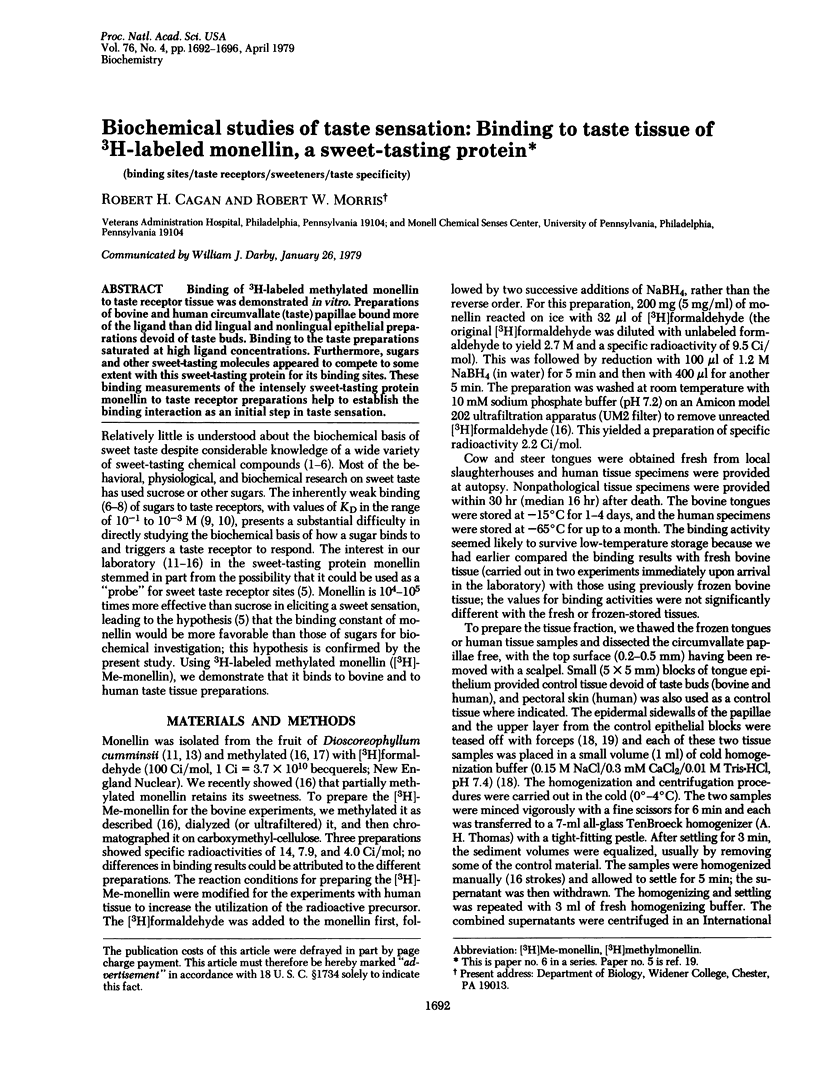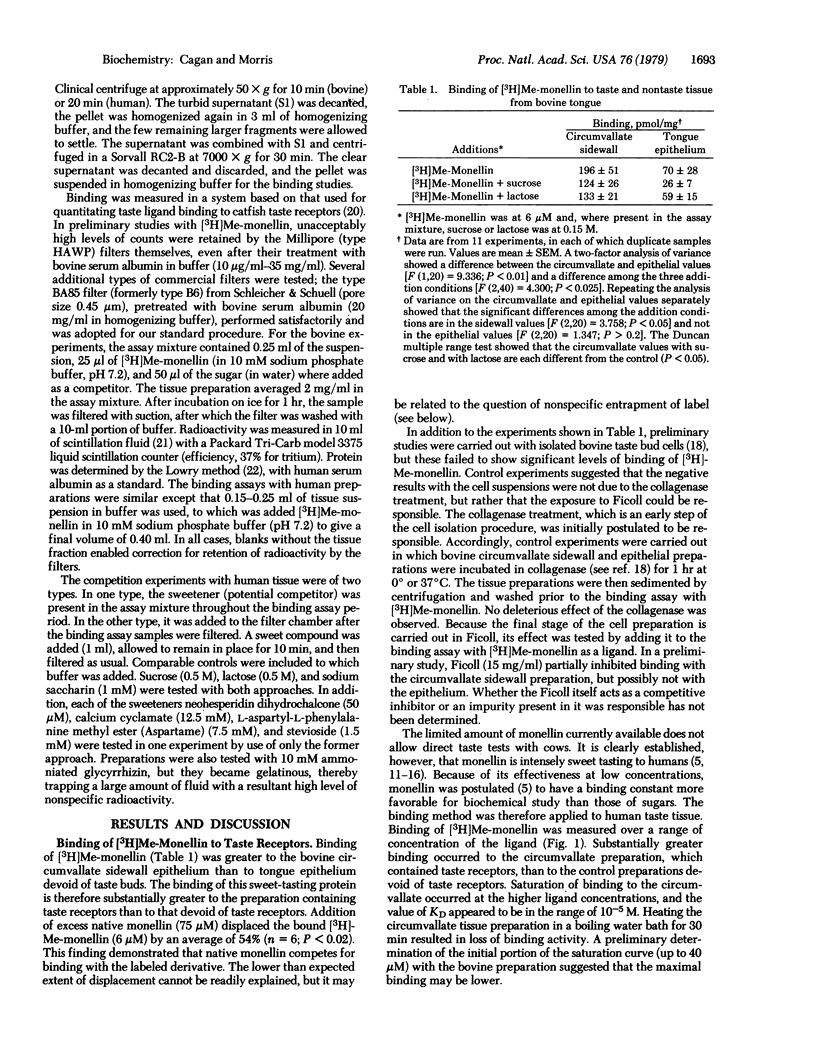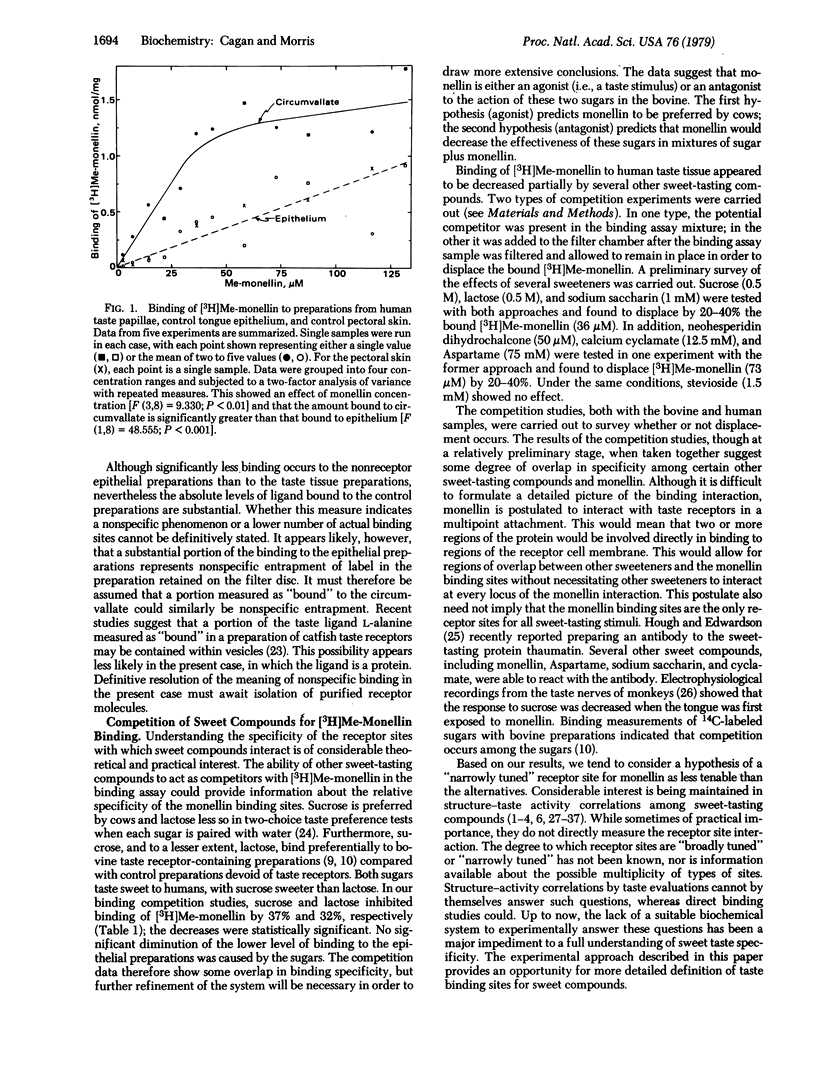Abstract
Binding of 3H-labeled methylated monellin to taste receptor tissue was demonstrated in vitro. Preparation of bovine and human circumvallate (taste) papillae bound more of the ligand than did lingual and nonlingual epithelial preparations devoid of taste buds. Binding to the taste preparations saturated at high ligand concentrations. Furthermore, sugars and other sweet-tasting molecules appeared to compete to some extent with this sweet-tasting protein for its binding sites. These binding measurements of the intensity sweet-tasting protein monellin to taste receptor preparations help to establish the binding interactions as an initial step taste sensation.
Full text
PDF




Selected References
These references are in PubMed. This may not be the complete list of references from this article.
- Acton E. M., Stone H. Potential new artificial sweetener from study of structure-taste relationships. Science. 1976 Aug 13;193(4253):584–586. doi: 10.1126/science.959816. [DOI] [PubMed] [Google Scholar]
- Birch G. G. Structural relationships of sugars to taste. CRC Crit Rev Food Sci Nutr. 1976 Sep;8(1):57–95. doi: 10.1080/10408397609527217. [DOI] [PubMed] [Google Scholar]
- Brand J. G., Cagan R. H. Biochemical studies of taste sensation. III. Preparation of a suspension of bovine taste bud cells and their labeling with a fluorescent probe. J Neurobiol. 1976 May;7(3):205–220. doi: 10.1002/neu.480070304. [DOI] [PubMed] [Google Scholar]
- Brand J. G., Zeeberg B. R., Cagan R. H. Biochemical studies of taste sensation. V. Binding of quinine to bovine taste papillae and taste bud cells. Int J Neurosci. 1976;7(1):37–43. doi: 10.3109/00207457609147199. [DOI] [PubMed] [Google Scholar]
- Brouwer J. N., Hellekant G., Kasahara Y., van der Wel H., Zotterman Y. Electrophysiological study of the gustatory effects of the sweet proteins monellin and thaumatin in monkey, guinea pig and rat. Acta Physiol Scand. 1973 Dec;89(4):550–557. doi: 10.1111/j.1748-1716.1973.tb05549.x. [DOI] [PubMed] [Google Scholar]
- Cagan R. H. Biochemical studies of taste sensation. I. Binding of 14 C-labeled sugars to bovine taste papillae. Biochim Biophys Acta. 1971 Oct;252(1):199–206. doi: 10.1016/0304-4165(71)90108-5. [DOI] [PubMed] [Google Scholar]
- Cagan R. H. Chemostimulatory protein: a new type of taste stimulus. Science. 1973 Jul 6;181(4094):32–35. doi: 10.1126/science.181.4094.32. [DOI] [PubMed] [Google Scholar]
- Cagan R. H., Morris J. A. The sulfhydryl group of monellin: its chemical reactivity and importance to the sweet taste. Proc Soc Exp Biol Med. 1976 Sep;152(4):635–640. doi: 10.3181/00379727-152-39457. [DOI] [PubMed] [Google Scholar]
- Dastoli F. R., Lopiekes D. V., Price S. A sweet-sensitive protein from bovine taste buds. Purification and partial characterization. Biochemistry. 1968 Mar;7(3):1160–1164. doi: 10.1021/bi00843a037. [DOI] [PubMed] [Google Scholar]
- Dastoli F. R., Price S. Sweet-sensitive protein from bovine taste buds: isolation and assay. Science. 1966 Nov 18;154(3751):905–907. doi: 10.1126/science.154.3751.905. [DOI] [PubMed] [Google Scholar]
- Dick W. E., Jr, Hodge J. E., Inglett G. E. Structure-taste relationships in (1 leads to 2)-linked disaccharides. Carbohydr Res. 1974 Sep;36(2):319–329. doi: 10.1016/s0008-6215(00)83053-0. [DOI] [PubMed] [Google Scholar]
- DuBois G. E., Crosby G. A., Stephenson R. A., Wingard R. E., Jr Dihydrochalcone sweeteners. Synthesis and sensory evaluation of sulfonate derivatives. J Agric Food Chem. 1977 Jul-Aug;25(4):763–772. doi: 10.1021/jf60212a056. [DOI] [PubMed] [Google Scholar]
- HAMOR G. H. Correlation of chemical structure and taste in the saccharin series. Science. 1961 Nov 3;134(3488):1416–1417. doi: 10.1126/science.134.3488.1416. [DOI] [PubMed] [Google Scholar]
- Hiji Y., Kobayashi N., Sato M. Sweet-sensitive protein from the rat tongue: its interaction with various sugars. Comp Biochem Physiol B. 1971 Jun 15;39(2):367–375. doi: 10.1016/0305-0491(71)90181-7. [DOI] [PubMed] [Google Scholar]
- Hiji Y., Sato M. Isolation of the sugar-binding protein from rat taste buds. Nat New Biol. 1973 Jul 18;244(133):91–93. doi: 10.1038/newbio244091a0. [DOI] [PubMed] [Google Scholar]
- Hough C. A., Edwardson J. A. Antibodies to thaumatin as a model of the sweet taste receptor. Nature. 1978 Jan 26;271(5643):381–383. doi: 10.1038/271381a0. [DOI] [PubMed] [Google Scholar]
- Koyama N., Kurihara K. Do unique proteins exist in taste buds? J Gen Physiol. 1971 Mar;57(3):297–302. doi: 10.1085/jgp.57.3.297. [DOI] [PMC free article] [PubMed] [Google Scholar]
- Krueger J. M., Cagan R. H. Biochemical studies of tast sensation. Binding of L-[3H]alanine to a sedimentable fraction from catfish barbel epithelium. J Biol Chem. 1976 Jan 10;251(1):88–97. [PubMed] [Google Scholar]
- LOWRY O. H., ROSEBROUGH N. J., FARR A. L., RANDALL R. J. Protein measurement with the Folin phenol reagent. J Biol Chem. 1951 Nov;193(1):265–275. [PubMed] [Google Scholar]
- Lapidus M., Sweeney M. L-4'-Cyano-3-(2,2,2-trifluoroacetamido)succinanilic acid and related synthetic sweetening agents. J Med Chem. 1973 Feb;16(2):163–166. doi: 10.1021/jm00260a019. [DOI] [PubMed] [Google Scholar]
- Lelj F., Tancredi T., Temussi P. A., Toniolo C. Interaction of alpha-L-aspartyl-L-phenylalanine methyl ester with the receptor site of the sweet taste bud. J Am Chem Soc. 1976 Oct 13;98(21):6669–6675. doi: 10.1021/ja00437a040. [DOI] [PubMed] [Google Scholar]
- Lum C. K., Henkin R. I. Sugar binding to purified fractions from bovine taste buds and epithelial tissue. Relationships to bioactivity. Biochim Biophys Acta. 1976 Feb 24;421(2):380–394. doi: 10.1016/0304-4165(76)90304-4. [DOI] [PubMed] [Google Scholar]
- Mazur R. H., Goldkamp A. H., James P. A., Schlatter J. M. Structure-taste relationships of aspartic acid amides. J Med Chem. 1970 Nov;13(6):1217–1221. doi: 10.1021/jm00300a046. [DOI] [PubMed] [Google Scholar]
- Mazur R. H., Reuter J. A., Swiatek K. A., Schlatter J. M. Synthetic sweeteners. 3. Aspartyl dipeptide esters from L- and D-alkylglycines. J Med Chem. 1973 Nov;16(11):1284–1287. doi: 10.1021/jm00269a014. [DOI] [PubMed] [Google Scholar]
- Mazur R. H., Schlatter J. M., Goldkamp A. H. Structure-taste relationships of some dipeptides. J Am Chem Soc. 1969 May 7;91(10):2684–2691. doi: 10.1021/ja01038a046. [DOI] [PubMed] [Google Scholar]
- Means G. E., Feeney R. E. Reductive alkylation of amino groups in proteins. Biochemistry. 1968 Jun;7(6):2192–2201. doi: 10.1021/bi00846a023. [DOI] [PubMed] [Google Scholar]
- Morris J. A., Cagan R. H. Effects of denaturants on the sweet-tasting protein monellin. Proc Soc Exp Biol Med. 1975 Nov;150(2):265–270. doi: 10.3181/00379727-150-39017. [DOI] [PubMed] [Google Scholar]
- Morris J. A., Cagan R. H. Purification of monellin, the sweet principle of Dioscoreophyllum cumminsii. Biochim Biophys Acta. 1972 Jan 28;261(1):114–122. doi: 10.1016/0304-4165(72)90320-0. [DOI] [PubMed] [Google Scholar]
- Morris J. A., Martenson R., Deibler G., Cagan R. H. Characterization of monellin, a protein that tastes sweet. J Biol Chem. 1973 Jan 25;248(2):534–539. [PubMed] [Google Scholar]
- Morris R. W., Cagan R. H., Martenson R. E., Deibler G. Methylation of the lysine residues of monellin. Proc Soc Exp Biol Med. 1978 Feb;157(2):194–199. doi: 10.3181/00379727-157-40019. [DOI] [PubMed] [Google Scholar]
- Nofre C., Sabadie J. A propos de la protéine linguale dite "sensible aux sucres". C R Acad Sci Hebd Seances Acad Sci D. 1972 May 24;274(21):2913–2915. [PubMed] [Google Scholar]
- Ostretsova I. B., Safarian E. Kh, Etingof R. N. O nalichii i lokalizatsii v iazyke belkov, sviazyvaiushchikh gliukozu. Dokl Akad Nauk SSSR. 1975 Aug 21;223(6):1484–1487. [PubMed] [Google Scholar]
- STEINHARDT R. G., Jr, CALVIN A. D., DODD E. A. Taste-structure correlation with alpha-D-mannose and beta-D-mannose. Science. 1962 Feb 2;135(3501):367–368. doi: 10.1126/science.135.3501.367. [DOI] [PubMed] [Google Scholar]
- Uehara S. Disc electrophoresis of extracts from the taste buds located in circumvallate papillae of rat tongues. J Gen Physiol. 1973 Mar;61(3):290–304. doi: 10.1085/jgp.61.3.290. [DOI] [PMC free article] [PubMed] [Google Scholar]


